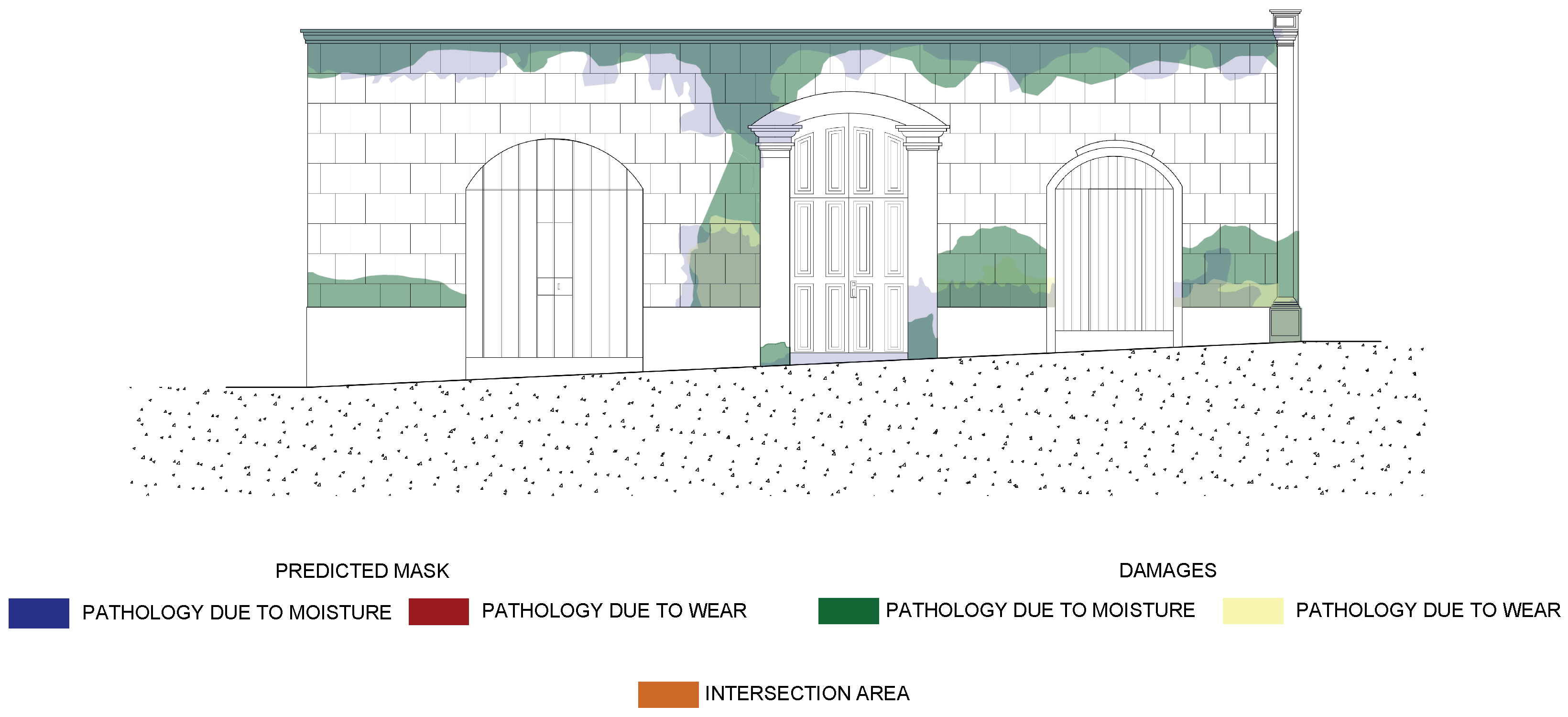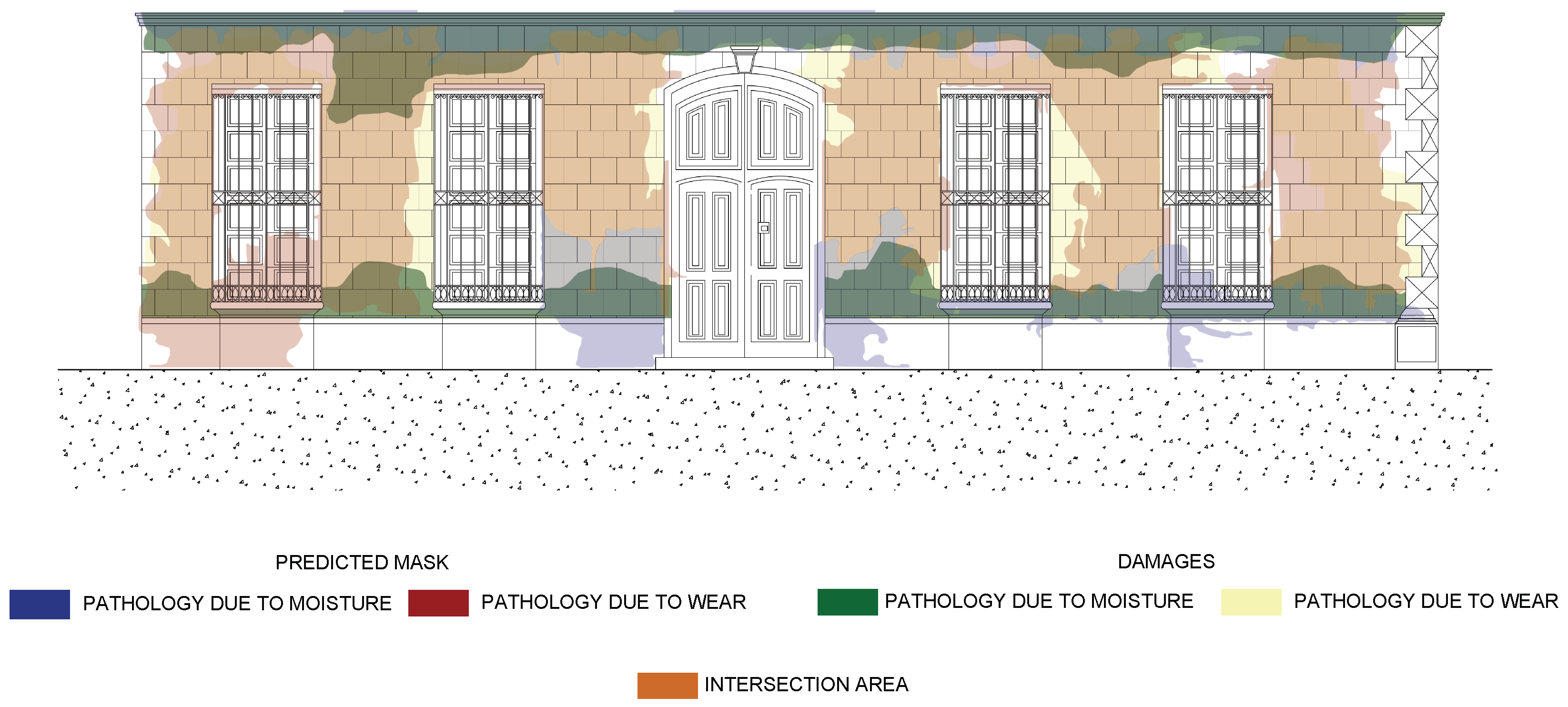Detection of Moisture and Surface Wear in Sillar Heritage Structures Using Deep Learning in Arequipa’s Architectural Heritage
Abstract
1. Introduction
1.1. Studies on Pathologies
1.2. Conservation Standards
1.3. Non-Destructive Testing Studies in Cultural Heritage
1.4. Deep Learning and Segmentation for Detection
1.5. Contribution to the Analysis of Sillar Deterioration in Architecture
2. Background Definitions
2.1. Definitions of Sillar
2.2. Classification
2.2.1. Classification According to Location
2.2.2. Petographic Classification
2.3. Properties
2.3.1. Porosimetry
2.3.2. Density
2.3.3. Absorption
2.3.4. Permeability
2.3.5. Endurance
2.3.6. Hardness
2.4. Definition of Pathology
2.5. Causes of Pathologies
2.5.1. Thermal Variation
2.5.2. Rising Humidity
2.5.3. Chemical Agents
2.6. Main Types of Pathologies
2.6.1. Surface or Granular Disintegration
2.6.2. Structural Cracking
2.6.3. Eruptions or New Growths
2.7. Non-Destructive Testing
3. Materials and Methods
3.1. Data Acquisition
3.2. Image Preprocessing
3.3. Initial Segmentation
3.4. Deep Segmentation
3.5. Validation
4. Results
4.1. Intersection over Union (IoU)
- : Area predicted and segmented by the model (Swin Transformer).
- : Real pathology area defined by visual inspection (real).
4.2. Percentage of Affected Area
- : Area affected by a specific pathology (moisture or surface wear).
- : Total surface area of the wall or building analyzed.
5. Discussion
6. Conclusions
Author Contributions
Funding
Institutional Review Board Statement
Informed Consent Statement
Data Availability Statement
Conflicts of Interest
Abbreviations
| DT | Digital Twin |
| BIM | Building Information Modeling |
| AI | Artificial Intelligence |
| IoT | Internet of Things |
| CV | Computer Vision |
| HBIM | Heritage Building Information Modeling |
| SV | Smart Vision |
| DL | Deep Learning |
| ANN | Artificial Neural Network |
| R-CNN | Region-Based Convolutional Neural Network |
| YOLO | You Only Look Once |
| mAP | Mean Average Precision |
| RGB | Red, Green, Blue |
| CIELab | CIE L*a*b* Color Space |
| SLIC | Simple Linear Iterative Clustering |
| IoU | Intersection Over Union |
| HSR | Schmidt Hammer Rebound |
| C | Capillarity |
| UPV | Ultrasound Pulse Velocity |
| Be | Beige |
| Pk | Pink |
| Wt | White |
| RCI | Río Chili Ignimbrite |
| LJI | La Joya Ignimbrite |
| AAI | Arequipa Airport Ignimbrite |
| YT | Yura Tuff |
| NII | Non-Invasive Inspection |
| NDE | Non-Destructive Evaluation |
| NDI | Non-Destructive Inspection |
| NDT | Non-Destructive Testing |
| UNESCO | United Nations Educational, Scientific and Cultural Organization |
References
- Torreblanca, M.; Choquehuanca, F.; Martínez, J.; Alfaro, M. Indicators of Cultural Ecosystem Services for Peri-Urban Agricultural and Natural Areas at an Intermediate Scale: A Case Study of Arequipa, Peru. Land 2024, 13, 1749. [Google Scholar] [CrossRef]
- Figueroa Pinedo, J.R. Arequipa and the Colca Valley: Tourism and Colonial Heritage in the Southern Andes. J. Tour. Herit. Res. 2019, 2, 302–321. Available online: https://jthr.es/index.php/journal/article/view/79 (accessed on 6 November 2025).
- Rivera García, A.D. Heritage Conservation and Tourism in the Historic Center of Arequipa, Peru. Ph.D. Thesis, University of Oregon, Eugene, OR, USA, 2011. Available online: https://hdl.handle.net/1794/11503 (accessed on 6 November 2025).
- Coll-Pla, S.; Medina-Sánchez, T.; Cuzziramos-Gutiérrez, F.; Mayta-Ponce, D.L.; Málaga-Montoya, D.; Costa-Jover, A.; Mallafrè-Balsells, C. The Significance of Public Space in Assessing Architectural Heritage. J. Archit. Urban. 2024, 48, 125–132. [Google Scholar] [CrossRef]
- Gonzales Ríos, V.; de La Vera Cruz Chávez, P.; Guzman Ale, R.; Lavalle Sullasi, H.S.; Manuel Mayhua Choque, F.; Chambi Laura, V.N. Estudio de Daños y Contaminacion Atmosferica en los Monumentos Historicos de la Ciudad de Arequipa, Perú. Rev. Noctua 2018, II, 63–89. [Google Scholar] [CrossRef]
- Uruchurtu, J. Dialnet. Efectos de la Contaminación en Edificios del Patrimonio Histórico. Available online: https://dialnet.unirioja.es/descarga/articulo/3059577.pdf (accessed on 6 November 2025).
- Zhu, P.; Zhang, H.; Sfarra, S.; Yang, D.; Maldague, X. A Review of Cultural Heritage Inspection: Toward Terahertz from Mid-Infrared Region. arXiv 2020. [Google Scholar] [CrossRef]
- ICOMOS ISC20C, Criterios de Conservación del Patrimonio Cultural del Siglo XX—Madrid–Nueva Delhi Document, Madrid/Nueva Delhi. 2017. Available online: https://isc20c.icomos.org/wp-content/uploads/2022/03/MNDD_SPANISH.pdf (accessed on 6 November 2025).
- Arafin, P.; Billah, A.M.; Issa, A. Deep Learning-Based Concrete Defects Classification and Detection Using Semantic Segmentation. Struct. Health Monit. 2023, 23, 383–409. [Google Scholar] [CrossRef]
- Díaz, D.P.; Barranco, H.G.; Calvo, H.L.; Guzmán, E.M.A. Uso de piedra ignimbrita como sustituto de agregado fino en morteros de cal para restauración. Cienc. Lat. Rev. Multidiscip. 2021, 5, 13344–13368. [Google Scholar] [CrossRef]
- Baduge, S.K.; Thilakarathna, S.; Perera, J.S.; Arashpour, M.; Sharafi, P.; Teodosio, B.; Shringi, A.; Mendis, P. Artificial Intelligence and Smart Vision for Building and Construction 4.0: Machine and Deep Learning Methods and Applications. Autom. Constr. 2022, 141, 104440. [Google Scholar] [CrossRef]
- Bruno, S.; Galantucci, R.; Musicco, A. Decay Detection in Historic Buildings through Image-Based Deep Learning. VITRUVIO Int. J. Archit. Technol. Sustain. 2023, 8, 18662. [Google Scholar] [CrossRef]
- Xie, J.; Li, M.; Wu, J.; Zhang, X.; Zhang, J. Semantic segmentation of building façade materials and colors for urban conservation. Npj Herit. Sci. 2025, 13, 378. [Google Scholar] [CrossRef]
- Nehring, G.; Gordon, N.; Rabin, I. Distinguishing between seemingly identical inks using scanning µXRF and heat maps. J. Cult. Herit. 2022, 57, 142–148. [Google Scholar] [CrossRef]
- Nieto Julián, J.; Bruno, S.; Moyano, J. An Efficient Process for the Management of the Deterioration and Conservation of Architectural Heritage: The HBIM Project of the Duomo of Molfetta (Italy). Remote Sens. 2024, 16, 4542. [Google Scholar] [CrossRef]
- Pozo-Antonio, J.S.; Cardell, C.; Comite, V.; Fermo, P. Caracterización de las costras negras desarrolladas en piedras históricas con diversa mineralogía en diferentes entornos de calidad del aire. Environ. Sci. Pollut. Res. 2022, 29, 29438–29454. [Google Scholar] [CrossRef] [PubMed]
- Ministerio de Cultura del Perú. Ley N.º 28296, Ley General del Patrimonio Cultural de la Nación; [General Law of the Cultural Heritage of the Nation]; Diario Oficial el Peruano: Lima, Peru, 22 July 2004; Available online: https://www.gob.pe/institucion/cultura/informes-publicaciones/455838-normas-sobre-proteccion-del-patrimonio-cultural (accessed on 1 November 2025).
- Ministerio de Educación del Perú. Decreto Supremo N.º 011-2006-ED: Reglamento de la Ley N.º 28296, Ley General del Patrimonio Cultural de la Nación; [General Law of the Cultural Heritage of the Nation]; Diario Oficial el Peruano: Lima, Peru, 2006; Available online: https://www.gob.pe/institucion/minedu/normas-legales/118132-011-2006-ed (accessed on 1 November 2025).
- Guolo, E.; Ruggeri, P.; Bison, P.; Peron, F. IR Thermography for Non-Destructive Monitoring of Moisture in Cultural Heritage. Eng. Proc. 2023, 51, 6. [Google Scholar] [CrossRef]
- Luib, A. Infrared Thermal Imaging as a Non-Destructive Investigation Method for Building Archaeological Purposes. Int. Arch. Photogramm. Remote. Sens. Spat. Inf. Sci. 2019, 42, 695–702. [Google Scholar] [CrossRef]
- del Pozo, S.; Rodríguez-Gonzálvez, P.; Sánchez-Aparicio, L.J.; Muñoz-Nieto, A.; Hernández-López, D.; Felipe-García, B.; González-Aguilera, D. Multispectral imaging in cultural heritage conservation. Int. Arch. Photogramm. Remote. Sens. Spat. Inf. Sci. 2017, 42, 155–162. [Google Scholar] [CrossRef]
- Giannuzzi, V.; Fatiguso, F. Historic Built Environment Assessment and Management by Deep Learning Techniques: A Scoping Review. Appl. Sci. 2024, 14, 7116. [Google Scholar] [CrossRef]
- Hatir, M.E.; Barstuğan, M.; İnce, İ. Deep learning-based weathering type recognition in historical stone monuments. J. Cult. Herit. 2020, 45, 193–203. [Google Scholar] [CrossRef]
- Katsigiannis, S.; Seyedzadeh, S.; Agapiou, A.; Ramzan, N. Deep learning for crack detection on masonry façades using limited data and transfer learning. J. Build. Eng. 2023, 76, 107105. [Google Scholar] [CrossRef]
- Gao, K.; Chen, L.; Li, Z.; Wu, Z. Automated Identification and Analysis of Cracks and Damage in Historical Buildings Using Advanced YOLO-Based Machine Vision Technology. Buildings 2025, 15, 2675. [Google Scholar] [CrossRef]
- Lebti, P.; Thouret, J.-C.; Wörner, G.; Fornari, M. Neogene and Quaternary Ignimbrites in the Area of Arequipa, Southern Peru: Stratigraphical and Petrological Correlations. J. Volcanol. Geotherm. Res. 2006, 154, 251–275. [Google Scholar] [CrossRef]
- Espinoza, F.S.; Horn, M.; Gómez, M.M.; Solís, J.L. Thermal, Structural and Mechanical Characterization of the Whitish Arequipa Airport Ignimbrite. J. Phys. Conf. Ser. 2021, 1841, 012010. [Google Scholar] [CrossRef]
- Bustamante, R.; Neyra, C.; Pino, R.; Álvarez, R.; Gil, D. Properties of the Ignimbrites in the Architecture of the Historical Center of Arequipa, Peru. Appl. Sci. 2021, 11, 10571. [Google Scholar] [CrossRef]
- Gisbert, J.; Baltuille, J.M.; Sánchez-Valverde, J.; Navarro, R.; Sebastián-Pardo, E. Caracterización y principales patologías de la arenisca “Piedra Dorada” empleada en los edificios históricos de las ciudades de Úbeda y Baeza (Jaén, Sur de España). Bol. Geológ. Min. 2017, 128, 379–393. [Google Scholar] [CrossRef]
- Harris, S.Y. Building Pathology: Deterioration, Diagnostics, and Intervention; Wiley: New York, NY, USA, 2001; ISBN 978-0471331728. [Google Scholar]
- Proietti, N.; Calicchia, P.; Colao, F.; De Simone, S.; Di Tullio, V.; Luvidi, L.; Prestileo, F.; Romani, M.; Tatì, A. Moisture Damage in Ancient Masonry: A Multidisciplinary Approach for In Situ Diagnostics. Minerals 2021, 11, 406. [Google Scholar] [CrossRef]
- Ximenes, C.; Jesus, J.; Aguiar, J. Surface pathology on the walls of limestone and mortar masonry. U.Porto J. Eng. 2023, 9, 3. [Google Scholar] [CrossRef]
- Elizalde, R.R. Marés Stone and Structural Slenderness: A Material-Based Diagnostic Study of Palma Cathedral. Constr. Mater. 2025, 5, 41. [Google Scholar] [CrossRef]
- Vargas Febres, C.; Rodríguez Salas, D.; Achahui Álvarez, A. Patologías mecanicas en elementos líticos de las iglesias patrimoniales en la Plaza Mayor de Cusco. Devenir 2021, 8, 137–154. [Google Scholar] [CrossRef]
- Loureiro, A.M.S.; Angélica, R.S.; Sanjad, T.A.B.C.; de Oliveira, M.M.; da Costa, M.L. Eflorescência salina na igreja de Santo Alexandre, Belém–PA. Ambiente Construído 2015, 15, 3. [Google Scholar] [CrossRef]
- Pehlivan, G.F. Analysis of Cultural Heritage by Non-Destructive Methods: The Case of Sivas Congress Museum. Archit. Urban Plan. 2023, 19, 1–16. [Google Scholar] [CrossRef]
- ICOMOS-ISCS. Illustrated Glossary on Stone Deterioration Patterns; ICOMOS: Paris, France, 2008. [Google Scholar]
- Garcia-Garcia, A.; Orts-Escolano, S.; Oprea, S.; Villena-Martinez, V.; Garcia-Rodriguez, J. A Review on Deep Learning Techniques Applied to Semantic Segmentation. arXiv 2017, arXiv:1704.06857. [Google Scholar] [CrossRef]
- Liu, Z.; Lin, Y.; Cao, Y.; Hu, H.; Wei, Y.; Zhang, Z.; Lin, S.; Guo, B. Swin Transformer: Hierarchical Vision Transformer using Shifted Windows. arXiv 2021, arXiv:2103.14030. [Google Scholar] [CrossRef]
- Hughes, A.C. Frictional Behaviour of Volcanic Debris Avalanches Following Catastrophic Flank Collapses. Ph.D. Thesis, University of Liverpool, Liverpool, UK, 2018. Available online: https://livrepository.liverpool.ac.uk/3021919/ (accessed on 6 November 2025).














Disclaimer/Publisher’s Note: The statements, opinions and data contained in all publications are solely those of the individual author(s) and contributor(s) and not of MDPI and/or the editor(s). MDPI and/or the editor(s) disclaim responsibility for any injury to people or property resulting from any ideas, methods, instructions or products referred to in the content. |
© 2025 by the authors. Licensee MDPI, Basel, Switzerland. This article is an open access article distributed under the terms and conditions of the Creative Commons Attribution (CC BY) license (https://creativecommons.org/licenses/by/4.0/).
Share and Cite
Valderrama Solis, F.A.; Nuñez Rodriguez, E.J.; Valderrama Solis, M.A.; Palomino Bellido, W.A. Detection of Moisture and Surface Wear in Sillar Heritage Structures Using Deep Learning in Arequipa’s Architectural Heritage. Architecture 2025, 5, 112. https://doi.org/10.3390/architecture5040112
Valderrama Solis FA, Nuñez Rodriguez EJ, Valderrama Solis MA, Palomino Bellido WA. Detection of Moisture and Surface Wear in Sillar Heritage Structures Using Deep Learning in Arequipa’s Architectural Heritage. Architecture. 2025; 5(4):112. https://doi.org/10.3390/architecture5040112
Chicago/Turabian StyleValderrama Solis, Fernando Alonso, Ericka Johany Nuñez Rodriguez, Manuel Alejandro Valderrama Solis, and William Alexander Palomino Bellido. 2025. "Detection of Moisture and Surface Wear in Sillar Heritage Structures Using Deep Learning in Arequipa’s Architectural Heritage" Architecture 5, no. 4: 112. https://doi.org/10.3390/architecture5040112
APA StyleValderrama Solis, F. A., Nuñez Rodriguez, E. J., Valderrama Solis, M. A., & Palomino Bellido, W. A. (2025). Detection of Moisture and Surface Wear in Sillar Heritage Structures Using Deep Learning in Arequipa’s Architectural Heritage. Architecture, 5(4), 112. https://doi.org/10.3390/architecture5040112




